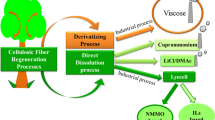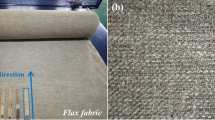Abstract
Polypyrrole was polymerized on the surface of cellulose fibres using a sequence of fibre impregnation in FeCl3 solutions, thickening and re-dispersion in a pyrrole solution. ζ-Potential and adsorption isotherms of the FeCl3-cellulose systems showed that the adsorption of iron III was associated with the formation of free Fe3+ cations in the impregnation liquor. Moreover, under the test conditions applied, the amount of adsorbed iron III was not sufficient to promote the polymerization of a adequate amount of pyrrole on the fibre surface. Optimization of the polymerization reaction required that the FeCl3 concentration in the impregnation liquor be increased to approximately 1 mol/l with a subsequent decrease of pH to approximately1.8. Based on scanning electron (SEM) micrographs and the low cellulose polymerization degree measured after pyrrole polymerization, we concluded that the decrease in the electric resistance of bulky polypyrrole/cellulose compounds was associated with a not negligible degradation of the cellulose fibres due to acid hydrolysis and the subsequent impossibility to prepare hand sheets with modified fibres due to the insufficient strength of the wet fibre network. The results of this investigation bring into question the use of FeCl3-pyrrole-cellulose systems for the elaboration of conducting paper sheets with good and stable mechanical properties.
Similar content being viewed by others
References
Baes C.F., Mesmer R.E. (1986) The Hydrolysis of Cations. Krieger Publ, Malabar, pp 226–237
Bouzek K., Mangold K.-M., Juttner K. (2001) Platinum distribution and electrocatalytic properties of modified polypyrrole films. Electrochim. Acta 46:661–670
Breslin C.B., Fenelon A.M., Conroy K.G. (2005) Surface engineering: corrosion protection using conducting polymers. Mat. Des. 26:233–237
Buschle-Diller G., Inglesby M.K., Wu Y. (2005) Physicochemical properties of chemically and enzymatically modified cellulosic surfaces. Colloids Surf. A 260:63–70
Careem M.A., Vidanapathirana K.P., Skaarup S., West K. (2004) Dependence of force produced by polypyrrole-based artificial muscles on ionic species involved. Solid State Ionics 175:725–728
Carpi F., De Rossi D. (2006) Colours from electroactive polymers : electrochromic, electroluminescent and laser devices based on organic materials. Optics Laser Tech. 38:292–305
Causley J., Stitzel S., Brady S., Diamond D., Wallace G. (2005) Electrochemically-induced fluid movement using polypyrrole. Synth. Met. 151:60–64
Charlot G. (1961) Dosages colorimetriques des éléments minéraux: principes et méthodes. Masson Ed., Paris
Dall’Acqua L., Tonin C., Peila R., Ferrero F., Catellani M. (2004) Performances and properties of intrinsic conductive cellulose-polypyrrole textiles. Synth. Met. 146:213–221
Diaz A.F., Bargon J. (1986) Handbook of Conducting Polymers, vol 1. Marcel-Dekker, New York
Gerard M., Chaubey A., Malhotra B.D. (2002) Application of conducting polymers to biosensors. Biosens. Bioelectron. 17:345–359
Högfeldt E. (1982) Stability Constants of metal-ion complexes, Part A: Inorganic Ligands IUPAC Chemical Data Series, No. 21. Pergamon Press, Oxford, pp 208–209
Huang B., Kang G.J., Ni Y. (2006) Preparation of conductive paper by in-situ polymerization of pyrrole in a pulp fibre system. Pulp Paper Can. 107:38–41
Huang J., Ichinose I. and Kunitake T. 2005. Nanocoating of natural cellulose fibers with conjugated polymer: hierarchical polypyrrole composite materials. Chem. Commun. 1717–1719
Johnston J.H., Moraes J., Borrman T. (2005a) Conducting polymers on paper fibres. Synth. Met. 153:65–68
Johnston J.H., Richardson M.J., Moraes J., Kelly F. and Borrmann T. 2005b. New conducting polymer and metallized composites with paper and wood and their potential applications. 59th APPITA Annual Conference and Exhibition Proceedings, Auckland, 16–19 May, pp. 167–171
Jolivet J.P. (2000) Metal Oxide Chemistry and Synthesis. John Wiley & Sons Ltd., Chichester, 59–69
Lin T., Wang L., Wang X., Kayan A. (2005) Polymerising pyrrole on polyester textiles and controlling the conductivity through coating thickness. Thin Solid Films 479:77–82
Omastova M., Trchova M., Kovarova J., Stejskal J. (2003) Synthesis and structural study of polypyrroles prepared in the presence of surfactants. Synth. Met. 138:447–455
Otero T.F., Cantero I. (1999) Conducting polymers as positive electrodes in rechargeable lithium-ion batteries. J. Power Sourc. 81–82:838–841
Otero T.F., Boyano I., Cortés M.T., Vazquez G. (2004) Nucleation, nonstoichiometry and sensing muscles from conducting polymers. Electrochim. Acta 49:3719–3726
Parkhurst, D.L. and Appelo, C.A.J., 1999. User’s guide to PHREEQC (version 2) – a computer program for speciation, batch-reaction, one-dimensional transport, and inverse geochemical calculations: U.S. Geological Survey Water-Resources Investigations Report 99–4259, 312 p
Schultze J.W., Karabulut H. (2005) Application potential of conducting polymers. Electrochim. Acta 50:1739–1745
Sik Jang K., Lee H., Moon B. (2004) Synthesis and characterization of water soluble polypyrrole doped with functional dopants. Synth. Met. 143:289–294
Song M-K., Kim Y-T., Kim B-S., Kim J., Char K., Rhee H-W. (2004) Synthesis and characterization of soluble polypyrrole doped with alkylbenzenesulfonic acids. Synth. Met. 141:315–319
Stana-Kleinschek K., Ribitsch V. (1998) Electrokinetic properties of processed cellulose fibers. Colloids Surf. A 140:127–138
TAPPI T230 05–76 (1976). Viscosity of pulp. Technical Association of the Paper and Pulp Industry
Varesano A., Dall’Acqua L., Tonin C. (2005) A study on the electrical conductivity decay of polypyrrole coated wool textiles. Polym. Degrad. Stab. 89:125–132
Wang L., Zhang Y., Gao P., Shi D., Liu H., Gao H. (2006) Changes in the structural properties and rate of hydrolysis of cotton fibers during extended enzymatic hydrolysis. Biotech. Bioeng. 93:443–456
Author information
Authors and Affiliations
Corresponding author
Rights and permissions
About this article
Cite this article
Beneventi, D., Alila, S., Boufi, S. et al. Polymerization of pyrrole on cellulose fibres using a FeCl3 impregnation- pyrrole polymerization sequence. Cellulose 13, 725–734 (2006). https://doi.org/10.1007/s10570-006-9077-9
Received:
Accepted:
Published:
Issue Date:
DOI: https://doi.org/10.1007/s10570-006-9077-9




